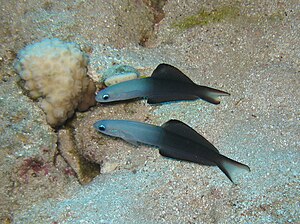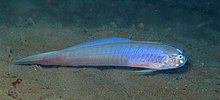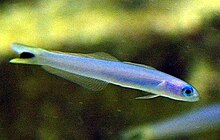Arrow and worm gobies
| Microdesmidae | ||||||||||
|---|---|---|---|---|---|---|---|---|---|---|
|
Obsolete systematic group The taxon dealt with here is not part of the systematics presented in the German-language Wikipedia. More information can be found in the article text. |
||||||||||

Scissor-tail torpedo legs ( Ptereleotris evides ) |
||||||||||
| Systematics | ||||||||||
|
||||||||||
| Scientific name | ||||||||||
| Microdesmidae | ||||||||||
| Regan , 1912 | ||||||||||
The arrow and worm gobies are a group of gobies (Gobiidae) that used to have the status of an independent family under the name Microdesmidae. They are small fish that occur in the tropical Indo-Pacific and in the tropical West Atlantic from the Caribbean to Brazil. Today the family is no longer valid. Together with the neotene genus Schindleria, however , the genera of the arrow or worm gobies form a monophyletic clade within the gobies.
features
The different types of the arrow and worm gobies are 4 to 30 centimeters long are laterally strongly flattened, elongated, the members of the subfamily of the worm gobies are eel-shaped. Their scales are small, cycloid, and embedded in the skin. The eyes are on the side of the head. The dorsal fin is long, extends over most of the body and in the worm gobies can have grown together with the caudal and anal fin to form a continuous fin edge. In the others, the caudal fin is separated from the dorsal and anal fin.
Way of life
The species of the arrow and worm gobies live as solitary animals, live in pairs or in small colonies, mostly at depths of 5 to 50 meters above open sand or mud bottoms and in coral reefs . Few species also go into brackish or fresh water. They feed on zooplankton , especially pelagic crustaceans and fish larvae, which they prey by swimming 20 to 100 centimeters above the ground with undulating movements. If disturbed, they disappear in a flash, upside down in caves they have dug themselves or in hiding places in the reef, where they also lay their eggs. They probably do brood care . The larvae are transparent and live pelagic .
Systematics
The Microdesmidae family was introduced in 1912 by the British ichthyologist Charles Tate Regan . At times the family only included the worm gobies and the so-called arrow gobies were placed in the independent family Ptereleotridae. Today all genera and species of both taxa belong to the gobies.
Genera and species
FishBase gives 86 species (including 31 worm goby species) in twelve genera for the family:
- Genus Aioliops Rennis & Hoese, 1987
- Aioliops brachypterus Rennis & Hoese, 1987 .
- Aioliops megastigma Rennis & Hoese, 1987 .
- Aioliops novaeguineae Rennis & Hoese, 1987 .
- Aioliops tetrophthalmus Rennis & Hoese, 1987 .
- Genus Cerdale
- Cerdale fasciata Dawson, 1974
- Cerdale floridana Longley, 1934
- Cerdale ionthas Jordan & Gilbert, 1882
- Cerdale paludicola Dawson, 1974
- Cerdale prolata Dawson, 1974
- Genus Clarkichthys
- Clarkichthys bilineatus (Clark, 1936)
- Genus Gunnellichthys
- Gunnellichthys copleyi (Smith, 1951)
- Neon striped goby ( Gunnellichthys curiosus ) Dawson, 1968
- Gunnellichthys grandoculis (Kendall & Goldsborough, 1911)
- Gunnellichthys irideus Smith, 1958
- Single point Wurmgrundel ( Gunnellichthys monostigma ) Smith, 1958
- Single-channel Wurmgrundel ( Gunnellichthys pleurotaenia ) Bleeker , 1858
- Orange-striped goby ( Gunnellichthys viridescens ) Dawson, 1968
- Genus Microdesmus
- Microdesmus aethiopicus (Chabanaud, 1927)
- Microdesmus affinis Meek & Hildebrand, 1928
- Microdesmus africanus Dawson, 1979
- Microdesmus bahianus Dawson, 1973
- Microdesmus carri Gilbert, 1966
- Microdesmus dipus Günther , 1864
- Microdesmus dorsipunctatus Dawson, 1968
- Microdesmus lanceolatus Dawson, 1962
- Microdesmus longipinnis (Weymouth, 1910)
- Microdesmus luscus Dawson, 1977
- Microdesmus retropinnis Jordan & Gilbert, 1882
- Microdesmus suttkusi Gilbert, 1966
-
Navigobius Hoese & Motomura, 2009 .
- Navigobius asayake Okamoto & Motomura, 2018 .
- Navigobius dewa Hoese & Motomura, 2009 .
- Navigobius kaguya Gill et al., 2017 .
- Navigobius vittatus Allen et al., 2015 .
- Genus Nemateleotris Fowler, 1938
- Decorative sword goby ( Nemateleotris decora ) Randall & Allen, 1973 .
- Nemateleotris exquisita Randall & Connell, 2013 .
- Helfrich's sword goby ( Nemateleotris helfrichi ) Randall & Allen, 1973 .
- Fire sword goby ( Nemateleotris magnifica ) Fowler, 1938 .
- Genus Oxymetopon Bleeker, 1861
- Oxymetopon compressus Chan, 1966 .
- Blue stripe torpedo base ( Oxymetopon cyanoctenosum ) Klausewitz & Condé, 1981 .
- Oxymetopon filamentosum Fourmanoir, 1967 .
- Oxymetopon formosum (Smith, 1931) .
- Oxymetopon typus Bleeker, 1861 .
- Genus Parioglossus Regan, 1912
- Parioglossus aporos Rennis & Hoese, 1985 .
- Parioglossus dotui Tomiyama, 1958 .
- Parioglossus formosus (Smith, 1931) .
- Parioglossus galzini Williams & Lecchini, 2004 .
- Parioglossus interruptus Suzuki & Senou, 1994 .
- Parioglossus lineatus Rennis & Hoese, 1985 .
- Parioglossus marginalis Rennis & Hoese, 1985 .
- Parioglossus multiradiatus Keith, Bosc & Valade, 2004 .
- Parioglossus neocaledonicus Dingerkus & Séret, 1992 .
- Parioglossus nudus Rennis & Hoese, 1985 .
- Parioglossus palustris (Herre, 1945) .
- Parioglossus philippinus (Herre, 1945) .
- Parioglossus rainfordi McCulloch, 1921 .
- Parioglossus raoi (Herre, 1939) .
- Parioglossus sinensis Zhong, 1994 .
- Parioglossus taeniatus Regan, 1912 .
- Parioglossus triquetrus Rennis & Hoese, 1985 .
- Parioglossus verticalis Rennis & Hoese, 1985 .
- Genus Paragunnellichthys
- Paragunnellichthys seychellensis Dawson, 1967
- Paragunnellichthys springeri Dawson, 1970
- Genus Ptereleotris Gill, 1863
- Ptereleotris arabica Randall & Hoese, 1985 .
- Ptereleotris calliura (Jordan & Gilbert, 1882) .
- Ptereleotris carinata Bussing, 2001 .
- Scissor-tail torpedo base ( Ptereleotris evides ) (Jordan & Hubbs, 1925) .
- Mauritius torpedo root ( Ptereleotris grammica ) Randall & Lubbock, 1982 .
- Blmen torpedo head ( Ptereleotris hanae ) (Jordan & Snyder, 1901) .
- Ptereleotris helenae (Randall, 1967) .
- Black-tailed torpedo base ( Ptereleotris heteroptera ) (Bleeker, 1855) .
- Ptereleotris lineopinnis (Fowler, 1935) .
- Ptereleotris melanopogon Randall & Hoese, 1985 .
- Ptereleotris microlepis (Bleeker, 1856) .
- Ptereleotris monoptera Randall & Hoese, 1985 .
- Ptereleotris randalli Gasparini, Rocha & Floeter, 2001 .
- Pacific torpedo torpedo ( Ptereleotris uroditaenia ) Randall & Hoese, 1985 .
- Zebra torpedo base ( Ptereleotris zebra ) (Fowler, 1938) .
- Genus Zagadkogobius Prokofiev, 2017
- Zagadkogobius ourlazon Prokofiev, 2017
Individual evidence
- ^ Joseph S. Nelson : Fishes of the World. Wiley, New York 2006, ISBN 0-471-25031-7 .
- ^ Hans A. Baensch , Helmut Debelius, Horst Moosleitner: Mergus Sea Water Atlas Volume 1 , Mergus-Verlag, Melle, 1997, ISBN 3-88244-110-0
- ^ A b Joseph S. Nelson, Terry C. Grande, Mark VH Wilson: Fishes of the World. Wiley, Hoboken, New Jersey, 2016, ISBN 978-1118342336
- ↑ a b Christine E. Thacker, Dawn M. Roje: Phylogeny of Gobiidae and identification of gobiid lineages. Systematics and Biodiversity (2011), 9 (4): 329-347, ISSN 1478-0933 doi : 10.1080 / 14772000.2011.629011
Web links
- Arrow and worm gobies on Fishbase.org (English)




